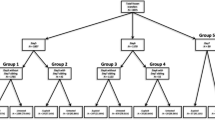Abstract
Purpose: The objective was to explore the variability in in vitro fertilization (IVF) success rates.
Methods: Published success rates from IVF clinics in North America were investigated to establish types of biases and potential inaccuracies.
Results: Success rates reported by IVF clinics vary with regard to the indices and patient populations used to compute them. Selection bias and misunderstood statistics are major factors contributing to the inappropriateness of certain rates.
Conclusions: The influence of privatization and market forces also may contribute to the need to oversimplify IVF statistics.
Similar content being viewed by others
REFERENCES
Soules MR: The in vitro fertilization pregnancy rate: Let's be honest with one another. Fertil Steril 1985;43:511-513
Hershlag A, Kaplan EH, Loy RA, DeCherney AH, Lavy G: Selection bias in in vitro fertilization programs. Am J Obstet Gynecol 1992;166:1-3
Page EW, Villee CA, Villee DB: Human Reproduction-Essentials of Reproductive and Perinatal Medicine. Toronto, WB Saunders Co., 1981
Wilcox LS, Peterson HB, Haseltine FP, Martin MC: Defining and interpreting pregnancy success rates for in vitro fertilization. Fertil Steril 1993;60:18-25
Garcia JE: Profiling assisted reproductive technology: The Society for Assisted Reproductive Technology registry and the rising costs of assisted reproductive technology. Fertil Steril 1998;69:624-626
Seibel MM, Bernstein J: Cost-effective trial balloons and the potential for bias: The case against in vitro fertilization. J Women's Health 1994;3:411-414
Page H: Calculating the effectiveness of in vitro fertilization. A review. Br J Obstet Gynecol 1989;96:334-339
Scoccia B, Blumenthal P, Wagner C, Prins G, Scommegna A, Marut E: Comparison of urinary human follicle-stimulating hormone and human menopausal gonadotropins for ovarian stimulation in an in vitro fertilization program. Fertil Steril 1987;48:446-449
Corabian P, Hailey D: The efficacy and adverse effects of in vitro fertilization and embryo transfer. Int J Technol Assess Health Care 1999;15:66-85
Yu V: Assisted reproduction technology, multiple births, and adverse perinatal outcome. Croatian Med J 1998;39:208-211
Porreco R, Schoolcraft C, Schoolcraft W: Pregnancy outcome following donor embryo replacement. J Matern Fetal Med 1997;6:237-240
Jones HW: The impact of in vitro fertilization on the practice of gynecology and obstetrics. Int J Fertil 1986;31:99-111
Ontario Ministry of Health: Medical Policy Bulletin. Kingston, Ontario Ministry of Health, 1995
SART (Society for Assisted Reproductive Technology and the American Society for Reproductive Medicine): Assisted reproductive technology in the United States and Canada: 1995 results generated from the American Society for Reproductive Medicine/Society for Assisted Reproductive Technology Registry. Fertil Steril 1998;69:389-396
Edelmann RJ, Connolly KJ, Bartlett H: Coping strategies and psychological adjustment of couples presenting for IVF. J Psychosom Res 1994;38:355-364
Daniels KR: Psychosocial factors for couples awaiting in vitro fertilization. Soc Work Health Care 1989;14:81-98
Civic Hospital. Goal Program,Ottawa Civic Hospital, Ottawa: http://www.cyberplus.ca/~conceive/, 1996
London Health Sciences Centre. Infertility Treatment: Services and Programs. London; University of Western Ontario, 1996
Yuzpe AA, Brown SE, Casper RF, Nisker JA, Graves G: Rates and outcomes of pregnancies achieved in the first 4 years of an in-vitro fertilization program. Can Med Assoc J 1989;140:167-172
Bergh C, Josefsson B, Nilsson L, Hamberger L: The success rate in Swedish in-vitro fertilization unit: A cohort study. Acta Obstet Gynecol Scand 1995;74:446-450
Tan S-L, Doyle P, Maconochie N, et al.: Pregnancy and birth rates of live infants after in vitro fertilization in women with and without previous in vitro fertilization pergnancies:Astudy of eight thousand cycles at one center. Am J Obstet Gynecol 1994;170:34-40
ASRM. The Society For Assisted Reproductive Technology and the American Society for Reproductive Medicine release 1993 ART success rates. Washington, DC: http://www. asrm.com/, 1995
Taylor PJ, Mahadevan M, Leader A, Wiseman D, Lorscheider F, Servis S: Initial experience with in vitro fertilization and embryo transfer at the University of Calgary Foothills Hospital. J In Vitro Fertil Embryo Transfer 1985;2:112-113
Author information
Authors and Affiliations
Rights and permissions
About this article
Cite this article
Deonandan, R., Campbell, M.K., Østbye, T. et al. Toward a More Meaningful In Vitro Fertilization Success Rate. J Assist Reprod Genet 17, 498–503 (2000). https://doi.org/10.1023/A:1009489624045
Issue Date:
DOI: https://doi.org/10.1023/A:1009489624045




